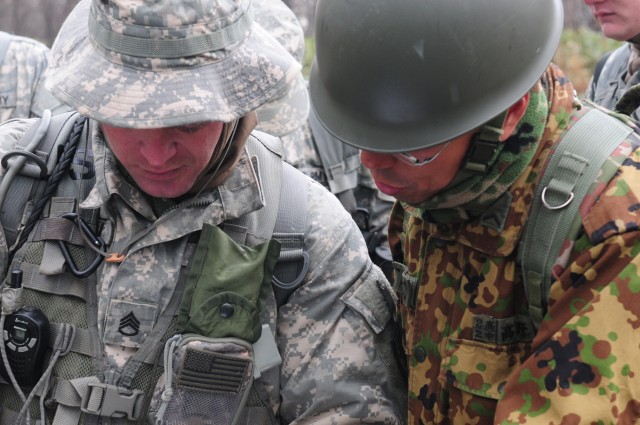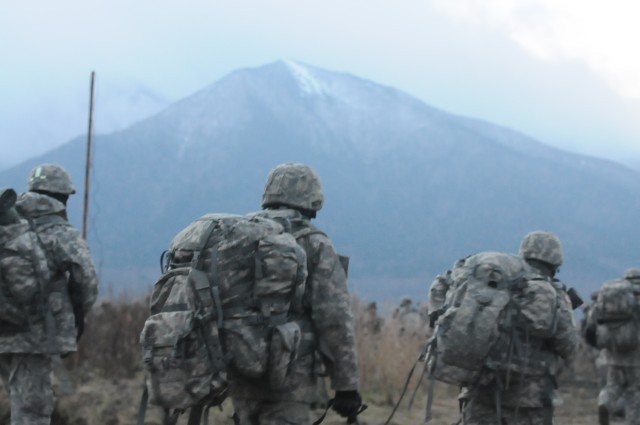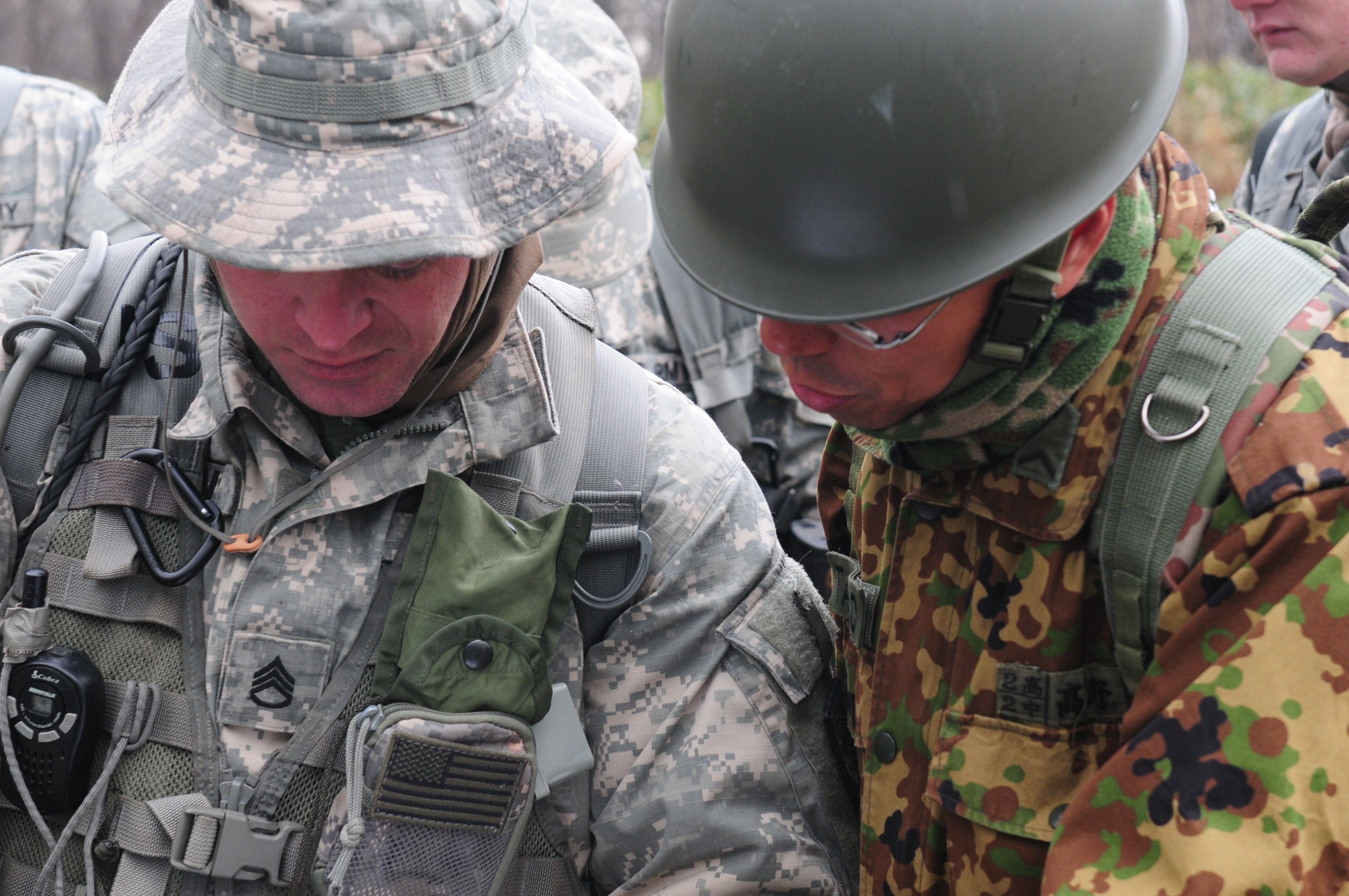KAMI-FURANO, Japan (Nov. 29, 2010) -- "Move, move, move! Enemy fire at nine o'clock; engage and fire!" barked leaders of the Missouri Army National Guard amidst helicopters touching down in the landing zone, small arms fire, mortars and grenade explosions.
It was all part of a training exercise in northern Japan in early November during Orient Shield 11, as the 1st Battalion, 138th Infantry Regiment based out of Kansas City, Mo., teamed with the 26th Infantry Regiment, Japanese Ground Self-Defense Force (JGSDF).
"This type of training experience only comes once in a blue moon," said Lt. Col. Kevin Fujimoto of St.Louis, Mo., commander of the 138th. "The Japanese Ground Self-Defense Force is one of the most professional, modern and disciplined military organizations I have ever seen. Just to train with such a professional army is an experience in itself."
Fujimoto said Orient Shield is a great opportunity for a Reserve Component to work with one of the United States' biggest allies.
"Together we can accomplish more than either one of us could apart," Fujimoto said.
The focus of the exercise was developing tactical, bilateral operations and war- fighting skills between the U.S. and Japanese militaries.
"Our main goal is to enhance the interoperability between the U.S. and Japan," said Col. Takeshi Hirano of Hiroshima, the regimental commander for 26th. "During this training we are learning the differences and similarities between the U.S. and Japan."
This training came less than two months after tensions flared between Japan and other eastern nations over islands in the region. The dispute is of interest to the United States because of a half-century-old agreement between America and Japan.
In 1960, the two countries signed the Treaty of Mutual Cooperation and Security, a binding agreement for both countries to support each other from enemy attack.
"Exercises like this encourage enduring professional mutual engagements and good will between the U.S. and Japan as we strengthen our relationship," said Maj. Gen. Michael Harrison, commander, United States Army Japan. "All participating U.S. Army units benefit in maintaining a bilateral partnership. Operations like Orient Shield serve as an opportunity to integrate and train all branches of the U.S. military, while building rapport between the U.S. and our allies."
About 400 Soldiers from National Guard units in New Hampshire, Illinois, Washington, Nevada, California and Missouri participated in the two-week training exercise called Orient Shield 11. More than half of these Soldiers were from the Missouri Army National Guard, who worked closely with their Japanese counterparts. The rest served as logistical support for the operation.
"This is a very important exercise," said 1st Lt. Taihei Hongo of Tacoma, Wash., a U.S. linguist from the Washington Army National Guard's 341st Military Intelligence team. Hongo was born in the United States, but has family in Japan. He has spent much of his life split between both countries.
"Japan is one of our closest allies and someone we wouldn't want to lose," Hongo said. "This has been a great experience. They are learning a lot from us and we are learning from them."
One week of training allowed the two countries an opportunity to collaborate and exchange military strategies, before the operation culminated in a field training exercise combining all of the shared techniques into a battle scenario. It quickly became clear that the two sides use similar military tactics.
"Interacting with our Japanese counterparts showed that their tactics and procedures are almost identical to ours," said 1st Sgt. Shannon Wilde of St. Elizabeth, Mo., first sergeant for Headquarters Company, 138th Infantry Battalion. "There are slight differences between us. There are some things they haven't thought of and others that we haven't thought of. It's good to exchange ideas."
Soldiers speaking two different languages are one of the most obvious difficulties, but translators helped fuse the gap to overcome the language barrier.
"Our counterparts perform the same jobs as we do, which makes it easier to communicate," said Sgt. Akiko Oota of Chitose, Japan, a member of Japan's 11th Infantry Regiment and a translator for the exercise.
Just as schools in the United States teach Spanish, Oota said Japanese students learn English in junior high and high school. This made training easier for the two allied nations.
"It has not been real hard," said Spc. Chie Yang of Cassville, Mo., with the 138th, who spent one week before the mission educating himself on the Japanese language. "Many of them speak decent English, and when we do not understand each other we use hand signals."
With wars ongoing in Iraq and Afghanistan, U.S. Soldiers have had a lot of exposure to different cultures. Most Soldiers working with the Japanese note distinct differences.
"The Japanese understand our language and culture better than the Iraqis and Afghans," said Sgt. Tyrel Naugle of Boonville, Mo., a member of the 138th who deployed to Iraq twice and spent one overseas tour in Afghanistan. "We are similar in many ways, including how we operate on the battlefield."
Sgt. 1st Class Bradford Connolly of Dunbarton, N.H., a member of the New Hampshire Army National Guard's medical detachment, said his best experience during the two-week exercise was working with his Japanese counterparts.
"I was so naAfA-ve to our relationship with Japan," Connolly said. "Before this, all I really knew was what my wife's grandfather said about Japan when he served during World War II."
Training in rain, sleet and snow didn't seem to hurt morale. Many Soldiers said the training surpassed their expectations and they learned a lot that could not be taught through training stateside.
"It is great to train in a realistic environment, and working with the Japanese in their own land is a unique experience," said Pfc. Jake Fendrick of Rolla, Mo., a member of the 138th. "It's nice to see their attitude in combat is similar to ours."
Wilde smiled when remembering a comment one of his Soldiers made during the training.
"They're just like us," this Soldier told the first sergeant, after spending time talking to a few of the Japanese Soldiers.
Wilde said his time interacting with the Japanese made one thing obvious to him.
"We all have something special that brought us into the military. Just like us, there was something inside of them that made them who they are, and encouraged them to be a Soldier."
This was the thirteenth year of Orient Shield, and U.S. and Japanese Soldiers continue to strengthen a growing relationship.
"I would go to war teamed up with the Japanese any day," said Pvt. Jonathan Rouse of Kansas City, Mo., a member of the 138th.
Related Links:
Army.mil: Asia and Pacific News
STAND-TO!: 50th Anniversary of US-Japan Treaty of Mutual Cooperation and Security




Social Sharing